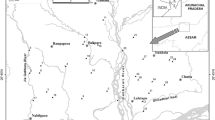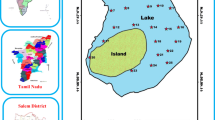Abstract
Multivariate statistical techniques such as multivariate analysis of variance (MANOVA) and discriminant analysis (DA) were applied for analyzing the data obtained from two rivers in the Penang State of Malaysia for the concentration of heavy metal ions (As, Cr, Cd, Zn, Cu, Pb, and Hg) using a flame atomic absorption spectrometry (F-AAS) for Cr, Cd, Zn, Cu, Pb, As and cold vapor atomic absorption spectrometry (CV-AAS) for Hg. The two locations of interest with 20 sampling points of each location were Kuala Juru (Juru River) and Bukit Tambun (Jejawi River). MANOVA showed a strong significant difference between the two rivers in terms of heavy metal concentrations in water samples. DA gave the best result to identify the relative contribution for all parameters in discriminating (distinguishing) the two rivers. It provided an important data reduction as it used four parameters (Zn, Pb, Cd and Cr) affording 100% correct assignations. Results indicated that the two rivers were different in terms of heavy metals concentrations in water, and the major difference was due to the contribution of Zn. A negative correlation was found between discriminate functions (DF) and Cr and As, whereas positive correlation was exhibited with other heavy metals. Therefore, DA allowed a reduction in the dimensionality of the data set, delineating a few indicator parameters responsible for large variations in heavy metal concentrations. Correlation matrix between the parameters exhibited a strong evidence of mutual dependence of these metals.
Similar content being viewed by others
References
Abd-wahab, S. A., Bakheit, C. S., & Al-Alawi, S. M. (2005). Principal component and multiple regression analysis in modelling of ground level ozone and factors affecting its concentrations. Environmental Modelling & Software, 20, 1263–1271.
Ahmet, D., Fevzi, Y., Tuna, A. L., & Nedim, O. (2006). Trace elements in Water, sediment and tissues of Leuciscus cephalus from a stream in southwestern Turkey. Chemosphere, 63, 1451–1458.
Alvin, C. R. (2002). Methods of multivariate analysis. Wiley.
APHA (1999). Standard Methods for the Examination of Water and Wastewater, 18th ed. American Publich Health Association (APHA), American Water Works Association (AWWA) and Water Pollution Control Federation (WPCF), Washington, DC.
Boughriet, A., Quddance, B., Fischer, J. C., Wartel, M., & Leman, G. (1992). Variability of dissolved Mn and Zn in the Seine Estuary and chemical speciation of these metals in suspended matter. Water Research, 26, 1359–1378.
DANCED (1998). Penang coastal profile. Integrated coastal zone management project report, Penang State Government. Malaysia.
Department of Environment (DOE) (1995). Environmental Quality Reports Ministry of Sciences Technology and Environment Malaysia: Annual Reports.
Department of Environment (DOE) (1999). Ministry of Science and Technology, Malaysia: Annual Report.
Department of Environment (DOE) (2000). Interim National Water Quality Standard for Malaysia. Ministry of Sciences Technology and Environment Malaysia: Annual Reports.
Einax, J. W., & Soldt, U. (1999). Geostatistical and multivariate statistical methods for the assessment of polluted soils; merits and limitations. Chemometrics and Intelligent Laboratory Systems, 46, 79–91.
EQA 1974 (2001). Laws of Malaysia: Environmental quality act and regulations. Kuala Lumpur: MDC.
Guo, T., DeLaune, R. D., & Patrick, W. H. (1997). The influence of sediment redox chemistry on chemically active forms of arsenic, cadmium, chromium, and zinc in estuarine sediment. Environment International, 23(3), 305–316.
Klavins, M., Briede, A., Rodinov, V., Kokorite, I., Parele, E., & Klavina, I. (2000). Trace elements in river of Lativa. Science of the Total Environment, 262, 175–183.
Mahajan, S. P. (1985). Pollution control in process industries. New Delhi: McGraw-Hill.
Pardo, R., Barrado, E., Perez, L., & Vega, M. (1990). Determination and association of trace elements in sediments of the Pisucrga, river. Water Research, 24(3), 373–379.
Richard, A. J., & Dean, W. W. (2002). Applied multivariate statistical analysis. Englewood Cliffs, NJ: Prentice-Hall.
Singh, K. P., Mohan, D., Singh, V. K., & Malik, A. (2005). Studies on distribution and fractionation of trace elements in Gomti river sediments- a tributary of the Ganges, India. Journal of Hydrology, 312, 14–27.
Tuncer, G. T., Tunce, S. G., Tuncel, G., & Balkas, T. I. (1993). Metal pollution in the Golden Horn, Turkey-contribution of natural and anthropogenic components since 1913. Water Science and Technology, 28, 59–64.
Yu, K.-Y., Tasi, L.-J., Chen, S.-H., & Ho, S. T. (2001). Chemical binding of trace elements in anoxic river sediments. Water Research, 35(7), 4086–4094.
Author information
Authors and Affiliations
Corresponding author
Rights and permissions
About this article
Cite this article
Alkarkhi, A.F.M., Ahmad, A., Ismail, N. et al. Multivariate analysis of heavy metals concentrations in river estuary. Environ Monit Assess 143, 179–186 (2008). https://doi.org/10.1007/s10661-007-9966-x
Received:
Accepted:
Published:
Issue Date:
DOI: https://doi.org/10.1007/s10661-007-9966-x




